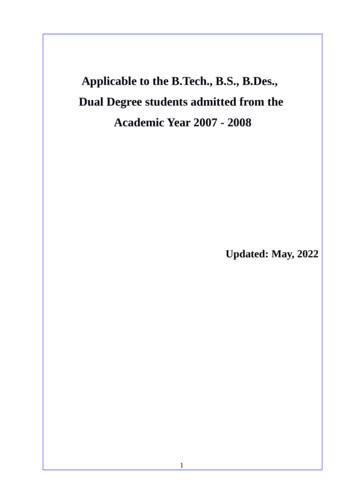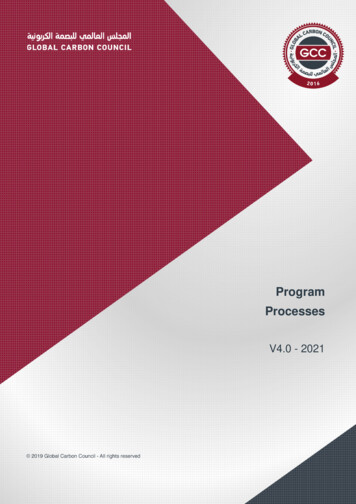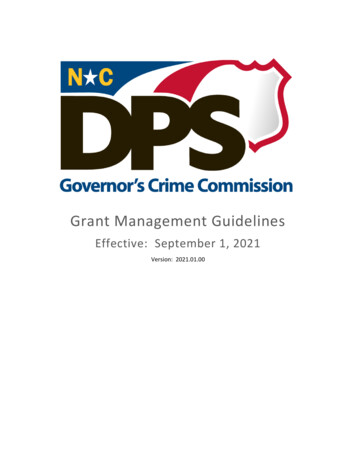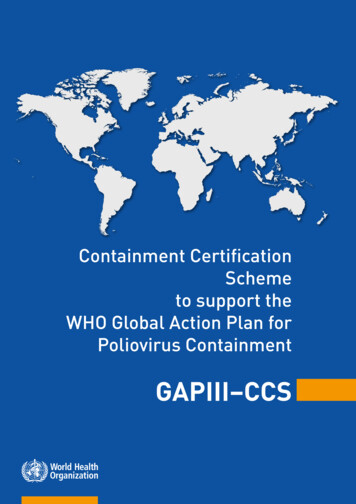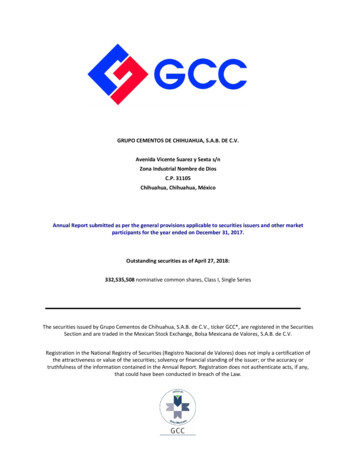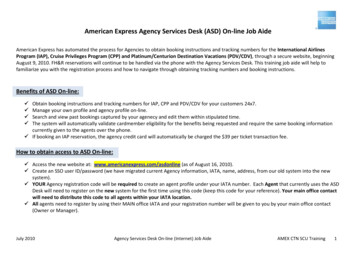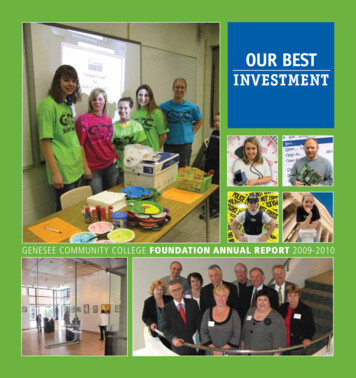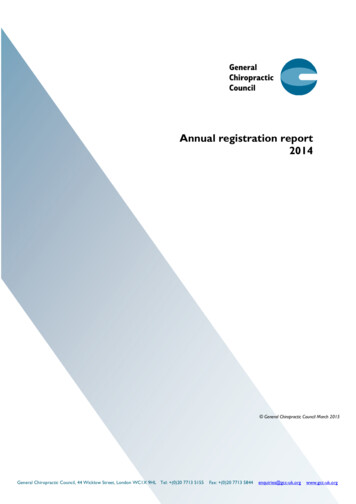
Transcription
Annual registration report2014 General Chiropractic Council March 2015General Chiropractic Council, 44 Wicklow Street, London WC1X 9HL Tel: (0)20 7713 5155Fax: (0)20 7713 5844enquiries@gcc-uk.orgwww.gcc-uk.org
Report on the 2014 GCC registration yearReport on the 2014 registration yearThis report provides an overview of the work undertaken by the registrations departmentof the General Chiropractic Council (GCC) during the period from 1 January to 31December 2014.New RegistrantsAn overview of 2014 new registrationsIn total 179 new registrants joined the GCC during 2014.This was an increase of 23 from2013, when 156 were registered. The monthly split of new registrants was as follows:Table 1 – number of new registrants during 2013 and 2014 by 56November135December83The chart below shows clearly where the peaks in initial registration applications occurred.Figure 1 – number of new registrants during 2014 by month50403020100Table 2 - 2014 new registrants by registration routeRegistration routeTotal new registrantsRoute 1 – UK accredited course159Route 2 – Foreign qualified13Route 3 – EU General Directive7Total179What this tells usThe majority of initial registration applications were received at the beginning of the year(January – February) and again from July to September. This follows graduation fromaccredited courses from the three UK institutions offering chiropractic training, and whichmakes up the vast majority of registration applications.General Chiropractic Council (www.gcc-uk.org)2 P a g e
Report on the 2014 GCC registration yearThe flow of work is largely in line with 2013, although there was a slight increase in newregistrants during November and December. This can be explained by a cohort from theMcTimoney College of Chiropractic (MCC) graduating in October in 2014 and thereforeapplying for registration earlier than the December cohort. This has led to their registrationfalling within the 2014 registration year rather than the following year as occurs with theDecember cohort. In previous years there have not been graduates from MCC in Octoberas all students graduated from December.In total 159 new registrants graduated from colleges with a GCC recognised qualificationand therefore made up the largest proportion of new registrants during 2014. Only 13 wereregistered on the basis that they held a foreign chiropractic qualification and by passing atest of competence, while the remaining 7 registrants where registered on the basis thatthey held EU community rights and had practised within the EEA.Routes to GCC registrationRoute 1 – by accredited course (UK)By holding a chiropractic qualification recognised for the purposes of registration by theGCC. As the GCC has only been asked to accredit courses within the UK, onlygraduates of relevant courses from the three UK colleges are eligible through this route,(Anglo-European College of Chiropractic, McTimoney College of Chiropractic and theUniversity of South Wales).Route 2 – unrecognised foreign chiropractic qualification (test of competence)By holding a chiropractic qualification from without the UK that meets the requirementsof the relevant GCC rules and also meeting the Standard of Proficiency by passing thetest of competence.Route 3 – EU General Directive (establishment)By virtue of European Union (EU) General Directive 2005/36/EC. Applicants mustpossess EU community rights and meet the requirements of establishment in anotherEuropean Economic Area (EEA) member state.Route 4 – EU General Directive (temporary and occasional)By virtue of European Union (EU) General Directive 2005/36/EC. Applicants mustpossess EU community rights, meet the requirements of establishment in anotherEuropean Economic Area (EEA) member state and also intend to practise in the UK onlyon a temporary and occasional basis.General Chiropractic Council (www.gcc-uk.org)3 P a g e
Report on the 2014 GCC registration yearApplicants holding a UK recognised qualification (route 1)The GCC recognises courses from three UK educational institutions. These are the onlyUK courses that allow individuals to apply for registration once completed.The breakdown below gives the numbers of 2014 graduates of accredited courses whowere granted registration by 1 March 2015.Table 3 – new registrants registered during 2014 by institutionEducationalMonth courseNumber imoneyCollege ofChiropractic(MCC)Anglo-EuropeanCollege ofChiropractic(AECC)University ofSouth WalesTotalDecember 20133631% of graduatesregisteredduring 201486.1June/ July 20141136053.1%June/ July 2014604575%-20913665.1What this tells usWhile roughly the same percentage of MCC graduates have gone on to register as from theDecember 2012 cohort, the percentage of graduates from both the AECC and theUniversity of South Wales are noticeably different from the 2013 figures.When comparing the figures for 2013, we see that a higher percentage of the 2014 AECCcohort registered, with 53.1% registering in 2014 compared to 43% in 2013. While 91.7% ofthe 2013 University of South Wales cohort registered, that figure dropped for 2014 to 75%.It’s worth bearing in mind that those who have not yet applied may do so at any time in thefuture as there is no time limit.We have estimated that of those who have not yet registered, some 80% are overseasnationals, with the remaining 20% made up of both UK and dual (including UK) nationality.This then falls within the range of our expectations and we would expect to see aproportion of graduates who are not yet registered applying in the future.General Chiropractic Council (www.gcc-uk.org)4 P a g e
Report on the 2014 GCC registration yearApplicants holding a relevant foreign chiropractic qualification (route 2)For those who achieved a chiropractic qualification outside the UK, GCC registration ispossible by applying to register and taking the additional step of passing a test ofcompetence. The test of competence is designed to ensure that those applicants who donot have a qualification accredited by the GCC meet the same standards as those who do.Table 4 – new foreign qualified registrants by educational institutionYear of graduation (totalEducationalCountryNumber ofgraduates in rbanSouth Africa12013LifeUSA12012Macquarie University Australia91992 (1)2010 (2)2012 (1)2013 (3)2014 (2)Southern CaliforniaUSA12011Total13What this tells usThe number of those applying by holding a relevant, unrecognised chiropractic qualificationis significantly smaller than those graduating from accredited courses, with an overall figureof those achieving registration via route 2 at 13.As was the case in 2013, over half of those granted registration during 2014 under theforeign qualification rules were graduates of Macquarie University, New South Wales,Australia. However, unlike 2013, where 100% of those granted registration had graduatedwithin the previous two years, in 2014 only 55% had done so.Those 13 registered through route 2 in 2014 graduated over a wider period of time, butfrom fewer colleges – seven colleges in 2013. However, given that the numbers remainsmall; minor fluctuations can dramatically change these figures.Test of CompetenceDuring 2014 the Test of Competence was administered on behalf of the GCC by theUniversity of South Wales.The GCC’s contract with the University of South Wales, for running the test came to anend in September 2014. During the period running up to the end of the contract the GCCreviewed the test and made arrangements for a new Test of Competence to be in place byJanuary 2015.General Chiropractic Council (www.gcc-uk.org)5 P a g e
Report on the 2014 GCC registration yearTable 5 – number of tests and candidates per annum since 2008YearNumber of testsNumber of testper yearattempts per 220Table 6 – breakdown of number of candidates per test for 2014Test datesNumber of candidates22 March1214 June813 SeptemberCancelledWhat this tells usIn line with figures for the past five years, the total number of candidates for the test hasremained around 20. Three tests were scheduled for 2014, although the final test inSeptember was subsequently cancelled as the minimum number of six candidates was notrealised.One possible reason for the lack of candidates may have been because some potentialcandidates held back from taking the September test in the belief the revised test ofcompetence would be easier.Breakdown by candidates graduating college for each testTable 7 – 22 March 2014 test of competenceInstitutionTotal candidates PassFailDurban110Life202Macquarie871South California 101Total1284General Chiropractic Council (www.gcc-uk.org)Resits116 P a g e
Report on the 2014 GCC registration yearTable 8 – 14 June 2014 test of competenceInstitutionTotal candidates PassLife31Macquarie22UniversityNew Zealand11South California 11Royal11MelbourneInstitute ofTechnologyTotal86Table 9 – total of candidates of all 2014 testsInstitutionTotal candidates PassDurban11Life51Macquarie109New Zealand11South California 21Royal11MelbourneInstitute 010Resits13001065What this tells usDemand for the test was higher at the beginning of the year as was also seen the previousyear. Essentially this is because the March test is the first test available to those newlygraduated from Macquarie University. Two thirds of candidates for the March test weregraduates from Macquarie University.With a figure of 70% for 2014, the pass rate was slightly lower than in 2013 with 76%, but inexcess of the mean pass rate of 66%.General Chiropractic Council (www.gcc-uk.org)7 P a g e
Report on the 2014 GCC registration yearTable 10 –failed test components for 2014ComponentNumber of attemptsClinical objectivestructured clinicalexamination (OSCE)UK healthcaresystemX-ray OSCECase management% of failed attempts6Number of failedattempts100006060100%16.6%Table 11 – number of candidates who failed by number of failed componentsNumber of failed componentsNumber of candidates15213040What this tells usAll six candidates failing the test during 2014 were unsuccessful on the case managementcomponent. Only one candidate failed a further component, in this case the Clinical OSCE.In contrast to 2013, no candidate failed the UK healthcare system or X-ray OSCEcomponents.Four candidates failed the test in March, although there was a lower percentage ofcandidates than for the June test which had fewer candidates.Applicants applying under European Union (EU) General Directive 2005/36/ECEstablishment (route 3)The number applying through the EU General Directive has remained at around the samelevel as 2013, with seven applicants. Those seven applied on the basis that they intended topractise within the UK on a permanent basis, which is referred to in the Directive as‘establishment’.General Chiropractic Council (www.gcc-uk.org)8 P a g e
Report on the 2014 GCC registration yearTable 12 – educational institution of those applying through the EU directiveEducational institutionCountryNumber ofYear of graduation (totalregistrantsgraduates in brackets)Insitut Franco-Européen deFrance62000 (1)Chiropraxie (IFEC)2013 (2)2014 (3)National University of HealthUSA12000 (1)SciencesTotal7What this tells usWith one exception all registrants applying through the EU general directive route wereFrench graduates of IFEC. Given the limited number of institutions offering chiropracticcourses in Europe, it’s of no surprise that a higher number were from France and the IFEC,although in comparison to 2013 the diversity of qualifications was much more limited. Wemay have expected to see a number of graduates from one of the other educationalinstitutions within the EU running chiropractic programmes, or even, as in the past moreapplicants with qualifications from outside the EU.Table 13 – nationality of those applying through the EU General DirectiveNationalityNumber of registrantsBritish1French6Total7What this tells usA comparison of 2013 and 2014 figures in relation to nationality shows that while Frenchnationals made up the largest contingent of registrants during 2013, it was not nearly aslarge as the 2014 contingent. It’s unclear at this stage whether this represents a pattern thatwill be repeated in future years.Temporary registration (route 4)2014 was the first time that the GCC had accepted an application under the directive fortemporary registration. The registrant was a French national holding a recent qualificationfrom IFEC. As they subsequently wished to remain in the UK, they have gained fullregistration under the EU General Directive on the basis of establishment and their data isincluded in the section above.General Chiropractic Council (www.gcc-uk.org)9 P a g e
Report on the 2014 GCC registration yearFuture application numbersBefore looking at any trends it should be mentioned that while we can consider previousstatistics to look for future trends, the many variables mean they should be considered as‘best guesses’ only.The largest variable is the number of new graduates who may apply for registration. This isparticularly important and difficult when forecasting using percentages since a small numberof graduates either applying or not applying for registration will have a disproportionateeffect. This can be seen by comparing the 2013 and 2014 figures for new UK graduatesapplying for registration, which shows that 123 out of the 210 graduates from 2013registered, equating to 58.6%, while in 2014 just 13 more graduates registered bringing thetotal to 136, increasing the percentage up to 65%.Also when forecasting numbers of new registrants for future years, the rate of attrition ofstudents comes into play and the further into the future the stones are cast the bigger theextrapolation has for error.Table 14 – potential graduates from UK educational institutions for the following five yearsAnglo-European College of ChiropracticUniversity of South WalesMcTimoney College of 068342222018110802921920191058028213What this tells usWhile the overall number of potential graduates remains between 213 and 228 for the nextfive years, there is some considerable difference in the number of graduates from eachinstitution in certain years, as shown in the shaded areas of table 14 above. While not asimportant as the total of potential graduates, it shows that there is capacity for dips ingraduates in some years that reduce the overall number wishing to apply for registration.Table 15 – projected registration figures for the following five yearsEducational institution20152016201720182019UK graduates*141134138136132Foreign Qualified1313131313EU Directive77777Total161154158156152* these figures have been calculated assuming a registration rate of 62% for UK graduates, which isthe average of the past two years.General Chiropractic Council (www.gcc-uk.org)10 P a g e
Report on the 2014 GCC registration yearFigure 2 - total of potential registrants for the following five years20015010050020152016201720182019What this tells usOver the next five years a period of relative stability in the number of new registrants is themost likely outcome. We are not aware of any factors currently that may dissuade largenumbers of new graduates from registering, nor that would prevent students fromcompleting their course.RetentionsSummaryBy the end of the 2014 retention period on 14 December 2014, 2,965 registrants hadretained on the Register for 2015.Factors affecting annual retention figures: as noted below, there are a number of reasons individuals will register as nonpractising there are a number of people who will leave the Register on an annual basis; and there are a number of individuals who will register for the first time after 10November each year in order to pay the initial registration fee rather than the initialregistration fee and the retention fee.These factors make it difficult to determine actual retention income for any period as wereply on past trends in forecasting.Non-practising rate of registrationSchedule 2 of the GCC (Registration) Rules 1999 allows a registrant not intending topractise as a chiropractor within the UK for the duration of the registration year to pay areduced fee of 100.At the end of December 2014 there were 277 registrants who had paid the 100 nonpractising rate as they did not intend practising in the UK during 2015, representing 10% ofthe profession in total.General Chiropractic Council (www.gcc-uk.org)11 P a g e
Report on the 2014 GCC registration yearTable 16 - reasons given for paying the non-practising registration rateNumber ofregistrantsHealthFinancialOverseas licensingTeachingTravellingEducationCareer changeSabbaticalUnknownNot working as a chiropractorMaternity/ Child careOverseasTotal122227811112532174277%age 5562.82100.00What this tells usMost of those paying the non-practising rate did so as they were practising, but outside ofthe GCC’s jurisdiction, making up over 60% of the total. The next largest group were thosetaking a break from their careers for maternity and child care reasons.Those who had changed careers and also those no longer working as chiropractors totalled33 registrants. Although we do not have data on what all of these individuals are doing, weare aware that some have gone through additional training to work in other healthcarefields. This does raise questions as to why those not intending to work in the chiropracticprofession again either wish to remain registered or are able to do so.Removals from the RegisterContinued registration is dependant upon registrants complying with all requirements ofregistration. Failure to meet those requirements can lead to removal from the Register.Removal from the Register can be for any of the following reasons:Failure to remain fit to practise (struck-off)Registrants who do not meet the standards as set out within the GCC’s Code of Practice/Standard of Proficiency, or who do not comply with GCC legislation, may be removed fromthe RegisterFailure to retain on the Register (lapse)All registrants must provide a full application for retention on the Register before thestatutory deadline of 30 November in any given registration year. Should the application notarrive by deadline a final warning notice is issued, allowing the registrant a further 14 days toensure their application for retention has arrived.General Chiropractic Council (www.gcc-uk.org)12 P a g e
Report on the 2014 GCC registration yearIf at the end of those 14 days the application has not arrived then removal from the Registeris automatic.Failure to complete annual CPD requirements (CPD non compliance)Each year all registered chiropractors must fill in and return a CPD record summary toshow the learning they have accomplished to comply with the GCC’s CPD scheme. Thoseregistrants who do not provide a summary, or who fail to meet the requirements of thescheme, may be removed from the Register.Voluntary removalIn addition to these, the GCC rules allow a registrant to remove his or her name from theRegister at any time by filling in the relevant application form and a statutory declaration.Table 17 - method of removal from the Register during 2014 by 001003Lapse101100000003639CPD nonVoluntary Deceased 42Total10431223045145107What this tells usEssentially table 17 tells us exactly what we would expect, that the majority of removalsfrom the Register fall in October at the end of the CPD period and after the retentionperiod in December. The remaining 17 removals occurred throughout the year and werelargely made up of voluntary removals, those who had died and those who were struck-offthe Register.General Chiropractic Council (www.gcc-uk.org)13 P a g e
Report on the 2014 GCC registration yearReasons for no longer remaining on the RegisterThese figures have been collated from voluntary removal application forms and emailcorrespondence with registrants. Where a registrant’s last known registered address wasoverseas, it has been accepted as the reason they did not wish to remain on the Register.Table 18 – reasons for no longer remaining on the RegisterAs aSince restoredNumber ofpercentageto the RegisterregistrantsFinancial oyed10.930Travelling10.931Dissatisfaction with the profession21.870Returned to education21.870Deceased21.870Career change32.800Health32.800Struck Off32.800Missed deadline to retain in king overseas3936.453Total107100.008What this tells usThere were a range of reasons for registrants no longer remaining on the Register. Over athird of those coming off the Register did so as they were no longer working in the UK. Aswe do not have data on 28% of leavers, this figure will in fact be higher.Table 19 - whether those coming off the Register were practising or non-practisingNumber of As a %age of As a %age ofremoversthe g3936%10%Total107100%100%General Chiropractic Council (www.gcc-uk.org)14 P a g e
Report on the 2014 GCC registration yearWhat this tells usA larger proportion of those coming off the Register during 2014 were non-practising thanpractising. We believe this is because registrants are cautious about coming off the Registerinitially and prefer to remain as non-practising in case their circumstances change. There isstill a perception among a small number of registrants that restoring to the Register is acomplicated process involving passing the test of competence, although this has never beenthe case.A comparison of the reasons given for paying the non-practising rate or leavingthe RegisterFig 3 - the main reasons given by those leaving the Register and those paying the nonpractising rate706050403020leavers10non‐practising0What this tells usFigure 3 shows that for both those registrants paying the non-practising rate and thoseleaving the Register, their main reason for doing so is an intention to practise overseas.There is some equity between the remaining categories, except for those on maternityleave/ child care, where substantially more pay the non-practising rate (32 registrants) thanleave the Register (one registrant) entirely.General Chiropractic Council (www.gcc-uk.org)15 P a g e
Report on the 2014 GCC registration yearDiversity of the RegisterThe sex and date of birth of all applicants is collected on the registration application form.Split by sex of new registrantsThe following data gives details of the split by sex for all those registered between 1 Januaryand 31 December 2014.Figure 4 - new registrants by sex605040302013202014100FemaleMaleWhat this tells usThe percentage of female new registrants in 2014 was 52.5%, which was 9% higher than2013. The split by sex within the profession has largely been 50:50 for some time, althoughin recent years there have been more male new registrants than female.The figures for 2014 show that the number of new male registrants remained around themid 80 mark, while there were an additional 26 new female registrants in 2014, which giventhe number of new registrants was only 179, is a significant number.Age split of new registrantsThe following data gives details of the age split for all those registered between 1 Januaryand 31 December in 2013 and 2014.Figure 5 - new registrants by age category70605040201330201420100Under 30 30 ‐ 4445 ‐ 49 Over 60General Chiropractic Council (www.gcc-uk.org)16 P a g e
Report on the 2014 GCC registration yearWhat this tells usNew registrants are largely made up of those under 30, which is as we would expect giventhat the majority of those are new graduates.Comparing 2014 figures with 2013 simply shows that this trend continues with a minorincrease in those under 30 and in the 45 – 49 brackets at the expense of those between 30and 44.Split by sex of the Register as a wholeFigures 6 – split by sex of registrants per year since 20065654525048464442FemaleMale2006 2007 2008 2009 2010 2011 2012 2013 2014What this tells usThere is a trend of almost a 50:50 split. The difference is now so small that there are fewerthan 10 individuals between the two totals with 1,513 male and 1,508 female.Spilt by age of the Register as a wholeFigure 7 – age split of the Register since 2006100%80%Over 6060%45‐5940%30‐4420%Under 300%2006 2007 2008 2009 2010 2011 2012 2013 2014General Chiropractic Council (www.gcc-uk.org)17 P a g e
Report on the 2014 GCC registration yearFigure 8 – age split of the Register since 20068060Under 454045 and over2002006 2007 2008 2009 2010 2011 2012 2013 2014What this tells usThe overall age profile of registrants was the same as for 2013. The general trend of areduction in the under 45 bracket and an increase in those over 46 seems to be levelling off,which may be as a result of stability in the number of new graduates and those leaving theRegister.CommunicationsDuring 2014 the registrations team engaged with stakeholders in a number of areas.New Continuing Professional Development (CPD) guidanceIn early April 2014 the GCC published revised guidance on its CPD scheme, resulting in themerging of two previous documents:1. Mandatory CPD guidance published in 2004; and2. CPD guidance published.The purpose of the revised document was to aid clarity, giving examples of the learning thatis acceptable as CPD and the learning that does not fall within the current scheme.However, given the terms used within the CPD rules themselves, it has not been possible toentirely avoid ambiguity.Revised dates for submission of annual CPD record summaryIn previous years registrants submitted their annual CPD record summary along with theirannual retention application, the deadline for which is the end of November each year. Thishas meant that the registrations section has not had an opportunity to check the content ofall CPD returns in the past. An emphasis has therefore been placed on confirming that thefull 30 hours have been completed and that all relevant sections of the summary have beenfilled in.In 2014 for the first time we brought the deadline for return of completed CPD recordsummaries forward to 30 September. The purpose of this change was to allow the officeGeneral Chiropractic Council (www.gcc-uk.org)18 P a g e
Report on the 2014 GCC registration yearenough time to check every summary and to ensure compliance with the CPD rules andguidance. Where issues are identified there is then enough time for these to be rectified.The vast majority of issues we identified were down to misinterpretation of the guidance byregistrants or summaries that did not give adequate information of either the identifiedlearning need or the learning activities themselves. In the majority of cases issues wereresolved quickly when registrants provided further detail.A report based on issues identified in the 2014 CPD returns has been compiled and fed intothe ongoing CPD review. It can also be found on the GCC website here.Monthly registration movement reportsSince January 2014 the GCC has produced a monthly report showing movements on theRegister of Chiropractors. This includes new registrants, those coming off the Register andwhen sanctions have been imposed upon registrants affecting their ability to practise.The report is published online and also circulated to professional associations and thoseprivate healthcare providers holding lists of chiropractors available to the public, this is tohelp ensure they are referring to up- to- date information.Registration of chiropractors in Isle of Man and GibraltarDuring 2014 the GCC was approached by the respective governments of both the Isle ofMan and Gibraltar, bringing in separate legalisation requiring all of those calling themselveschiropractors within their jurisdictions to hold registration with the GCC.A memorandum of understanding was signed with the Isle of Man Government during 2014and, a further memorandum was agreed with the authorities in Gibraltar and signed on 14January 2015.General Chiropractic Council (www.gcc-uk.org)19 P a g e
Report on the 2014 GCC registration yearFor further information on registrations or CPD, please contact:Registrations teamGeneral Chiropractic Council44 Wicklow StreetLondonWC1X 9HL020 7713 5155www.gcc-uk.orgenquiries@gcc-uk.orgGeneral Chiropractic Council (www.gcc-uk.org)20 P a g e
General Chiropractic Council, 44 Wicklow Street, London WC1X 9HL Tel: (0)20 7713 5155 Fax: (0)20 7713 5844 enquiries@gcc-uk.org www.gcc-uk.org . In total 159 new registrants graduated from colleges with a GCC recognised qualification . Southern California USA 1 2011 Total - 13 -

